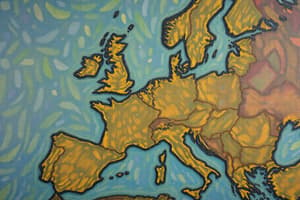Podcast
Questions and Answers
L'Europe est le continent le plus peuplé?
L'Europe est le continent le plus peuplé?
False (B)
Les frontières de l'Europe sont clairement définies?
Les frontières de l'Europe sont clairement définies?
False (B)
Paris est la capitale de l'Espagne?
Paris est la capitale de l'Espagne?
False (B)
Londres est un centre financier mondial et un important pôle culturel?
Londres est un centre financier mondial et un important pôle culturel?
L'océan Atlantique borde l'Europe à l'est et au sud?
L'océan Atlantique borde l'Europe à l'est et au sud?
Rome est la capitale de l'Allemagne.
Rome est la capitale de l'Allemagne.
Berlin est connue pour sa cuisine, ses musées et ses sites historiques.
Berlin est connue pour sa cuisine, ses musées et ses sites historiques.
Madrid est principalement connue pour son architecture moderne et son urbanisme innovant.
Madrid est principalement connue pour son architecture moderne et son urbanisme innovant.
Helsinki est un site du patrimoine mondial de l'UNESCO en raison de son architecture ancienne et de ses ruines antiques.
Helsinki est un site du patrimoine mondial de l'UNESCO en raison de son architecture ancienne et de ses ruines antiques.
La Belgique est un État fédéral avec une seule langue officielle.
La Belgique est un État fédéral avec une seule langue officielle.
Study Notes
Introduction
Europe, the second-smallest continent in both area and population, is known for its diverse cultures, languages, and landscapes. In this article, we will delve into the geography of Europe, focusing on the borders, capitals, and countries that make up this fascinating continent.
Frontières européennes
Europe's borders are not clearly defined, as many countries share historical, cultural, and economic ties with their neighbors. The continent is generally bounded by the Atlantic Ocean to the west and north, the Arctic Ocean to the north, the Mediterranean Sea to the south, and Asia to the east. The European borders are not fixed and have changed over time due to political, military, and economic factors.
Les capitales européennes
Each European country has its own capital city, serving as the political, economic, and cultural center of the nation. Some of the most notable European capital cities include:
-
London, United Kingdom: The capital city of the UK, London is a global financial center and a major cultural hub, with a rich history and diverse population.
-
Paris, France: Known as the "City of Light," Paris is a global center for art, fashion, gastronomy, and culture, with iconic landmarks like the Eiffel Tower and Notre-Dame.
-
Rome, Italy: As the capital of Italy and one of the oldest continuously inhabited cities in Europe, Rome is a UNESCO World Heritage site with centuries-old architecture and ancient ruins.
-
Berlin, Germany: The capital and largest city of Germany, Berlin is a major political and cultural center, with a diverse population and an abundance of museums, art galleries, and historical sites.
-
Madrid, Spain: The capital and largest city of Spain, Madrid is a global center for art and culture, with a vibrant nightlife scene, world-class museums, and historic landmarks.
-
Helsinki, Finland: The capital and largest city of Finland, Helsinki is a UNESCO City of Design, known for its modern architecture, design, and innovative urban planning.
-
Brussels, Belgium: The capital of both Belgium and the European Union, Brussels is a hub for international diplomacy and administration, with a diverse population and a rich cultural heritage.
-
Warsaw, Poland: The capital and largest city of Poland, Warsaw is a center for business, culture, and education, with a mix of modern architecture and historic buildings.
Les pays européens
Europe is home to a diverse array of countries, each with its own unique culture, language, and history. Some of the most notable European nations include:
-
United Kingdom: Comprising England, Scotland, Wales, and Northern Ireland, the UK is a constitutional monarchy with a rich history and diverse cultural heritage.
-
France: As the most populous European country, France is known for its art, fashion, and cuisine, with iconic landmarks like the Eiffel Tower and the Louvre Museum.
-
Germany: The largest country in the European Union, Germany is a major economic and political power, with a diverse population and a rich history.
-
Italy: A founding member of the European Union, Italy is known for its art, architecture, and cuisine, with iconic landmarks like the Colosseum and the Leaning Tower of Pisa.
-
Spain: The second-largest country in Europe, Spain is a diverse nation with a rich history, cultural heritage, and beautiful landscapes.
-
Poland: As the largest country in Central Europe, Poland is a democratic republic with a diverse population and a rich cultural heritage.
-
Finland: A democratic republic with a high standard of living, Finland is known for its modern architecture, design, and innovative urban planning.
-
Belgium: A founding member of the European Union, Belgium is a federal state with three official languages and a diverse population.
Each of these countries offers unique experiences and attractions for visitors, making Europe a fascinating and diverse continent to explore.
Conclusion
Europe's borders, capitals, and countries are as diverse as the people who inhabit them. From the historic landmarks and cultural centers to the beautiful landscapes and vibrant cities, Europe is a continent full of wonder and discovery. Whether you're a history buff, a foodie, or an adventure seeker, there's something for everyone in this incredible continent.
Studying That Suits You
Use AI to generate personalized quizzes and flashcards to suit your learning preferences.
Description
Explore the diverse geography of Europe, including its ever-changing borders, iconic capital cities, and unique nations. Learn about the historic landmarks, cultural centers, and beautiful landscapes that make Europe a fascinating continent to discover.




